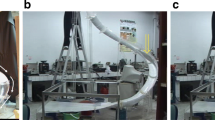Abstract
When characterizing geologic natural hazards, specifically granular flows including pyroclastic flows, debris avalanches and debris flows, perhaps the most important factor to consider is the area of inundation. One of the key parameters demarcating the leading edge of inundation is the run-out distance. To define the run-out distance, it is necessary to know when the flow stops. Numerical experiments are presented for determining a stopping criterion and exploring the suitability of the Savage-Hutter theory for computing inundation areas of granular flows. The stopping criterion is a function of dimensionless average velocity, pile aspect ratio and internal and bed friction angle and can be implemented on either a global (entire flow) or local (small areas of the flow) level. Slumping piles on a horizontal surface, and geophysical flows over complex topography were simulated. Mountainous areas, such as Colima volcano, Mexico; Casita, Nicaragua; Little Tahoma Peak, USA, and the San Bernardino Mountains, USA, were used as test regions. These areas have combinations of steep, open slopes and sinuous channels. Because of differences in topography and physical scaling, slumping piles in the laboratory and geophysical flows in natural terrain must be scaled differently to determine a reasonable dimensionless relationship for the stopping criterion.










Similar content being viewed by others
References
Cannon SH, Gartner JE, Wilson RC, Bowers JC, Laber JL (2008) Storm rainfall conditions for floods and debris flows from recently burned areas in southwestern Colorado and southern California. Geomorphology 96:250–269
Crandell DR, Fahnestock RK (1965) Rockfalls and avalanches from little Tahoma Peak on Mount Rainier, Washington. US Geol Surv Bull 1221-A:A1–A30
Denlinger RP, Iverson RM (2001) Flow of variably fluidized granular masses across three-dimensional terrain 2. Numerical predictions and experimental tests. J Geophys Res 106(B1):553–566
Denlinger RP, Iverson RM (2004) Granular avalanches across irregular three-dimensional terrain: 1. Theory and computation. J Geophys Res 109(F01014):1–14
Doyle E, Huppert H, Lube G, Mader H, Sparks S (2007) Satic and flowing regions in granular collapse down channels: insights from a sedimenting shallow water model. Phys Fluids 19:106601
Fairchild LH, Wigmosta M (1983) Dynamic and volumetric characteristics of the 18 May 1980 lahars on the Toutle River, Washington. In: Proceeding of the symposium on erosion control in volcanic areas technical memorandum 1908. Japan Public Works Research Institute, Ministry of Construction, Tokyo, pp 131–153
Gray JMNT, Wieland M, Hutter K (1999) Gravity-driven free surface flow of granular avalanches over complex basal topography. Proc Roy Soc London Ser A 455:1841–1874
Iverson RM, Denlinger RP (2001) Flow of variably fluidized granular masses across three-dimensional terrain 1. Coulomb mixture theory. J Geophys Res 106(B1):537–552
Lajeunesse E, Mangeney-Castelnau A, Vilotte JP (2004) Spreading of a granular mass on a horizontal plane. Phys Fluids 16(7):2371–2381
Lube G, Huppert H, Sparks S, Hallworth M (2004) Axisymmetric collapses of granular columns. J Fluid Mech 508:175
Lube G, Huppert HE, Sparks RSJ, Freundt A (2005) Collapses of two-dimensional granular columns. Phys Rev E Stat Nonlin Soft Matter Phys 72(4130):1–11
Mangeney-Castelnau A, Vilotte JP, Bristeau MO, Perthame B, Bouchut F, Simeoni C, Yerneni S (2003) Numerical modeling of avalanches based on Saint-Venant equations using a kinetic scheme. J Geophys Res 108(B11):2527
Molinaro P, Natale L (eds) (1994) Modelling of flood propagation over initially dry areas. American Society of Civil Engineers, New York, 373 pp
Patra AK, Bauer AC, Nichita CC, Pitman EB, Sheridan MF, Bursik M, Rupp B, Webber A, Stinton AJ, Namikawa LM, Renschler CS (2005) Parallel adaptive numerical simulation of dry avalanches over natural terrain. J Volcanol Geotherm Res 139:1–21
Pierson TC (1985) Initiation and flow behavior of the 1980 Pine Creek and Muddy river lahars, Mount St. Helens, Washington. Geol Soc Am Bull 96:1056–1069
Plafker G, Ericksen GE (1978) Nevado Huascaran avalanches, Peru. In: Voight B (ed) Rockslides and avalanches, vol 1: natural phenomena. Elsevier, New York, pp 277–314
Pouliquen O (1999) Scaling laws in granular flows down rough incline planes. Phys Fluids 11:542–548
Pouliquen O, Forterre Y (2002) Friction law for dense granular flows: application to the motion of a mass down a rough inclined plane. J Fluid Mech 453:133–151
Pudasaini SP, Hutter K (2003) Rapid shear flows of dry granular masses down curved and twisted channels. J Fluid Mech 495:193–208
Pudasaini SP, Hutter K (2007) Avalanche dynamics: dynamics of rapid flows of dense granular avalanches. Springer, Berlin
Rupp B, Bursik M, Namikawa L, Webb A, Patra AK, Saucedo R, Macias JL, Renschler C (2006) Computational modeling of the 1991 block and ash flows at Colima Volcano, Mexico. In: Siebe C, Macias JL, Aguirre-Diaz GJ (eds) Neogene-quaternary continental margin volcanism: a perspective from Mexico. Geological Society of America special paper 402, pp 223–237. doi:10.1130/2006.2402(11)
Saucedo R, Macias JL, Sheridan MF, Bursik MI, Komorowski JC (2005) Modeling of pyroclastic flows of Colima volcano, Mexico: implications for hazard assessment. J Volcanol Geotherm Res 139:103–115
Savage S, Hutter K (1989) The motion of a finite mass of granular material down a rough incline. J Fluid Mech 199:177–215
Scott KM, Vallance JW, Kerle N, Macias JL, Strauch W, Devoli G (2004) Catastrophic precipitation-triggered lahar at Casita volcano, Nicaragua: occurrence, bulking and transformation. Earth Surf Process Landf 30:59–79
Sheridan MF, Stinton AJ, Patra A, Pitman EB, Bauer A, Nichita CC (2005) Evaluating Titan2D mass-flow model using the 1963 Little Tahoma Peak avalanches, Mount Rainier, Washington. J Volcanol Geotherm Res 139:89–102
Vallance JW, Scott KM (1997) The Osceola mudflow from Mount Rainier: sedimentology and hazard implications of huge clay-rich debris flow. Geol Soc Am Bull 109(2):143–163
Acknowledgments
We thank two anonymous reviewers for very thorough reviews that improved the article. The research was supported by National Science Foundation grants ITR0121254 and EAR06209991.
Author information
Authors and Affiliations
Corresponding author
Rights and permissions
About this article
Cite this article
Yu, B., Dalbey, K., Webb, A. et al. Numerical issues in computing inundation areas over natural terrains using Savage-Hutter theory. Nat Hazards 50, 249–267 (2009). https://doi.org/10.1007/s11069-008-9336-1
Received:
Accepted:
Published:
Issue Date:
DOI: https://doi.org/10.1007/s11069-008-9336-1




